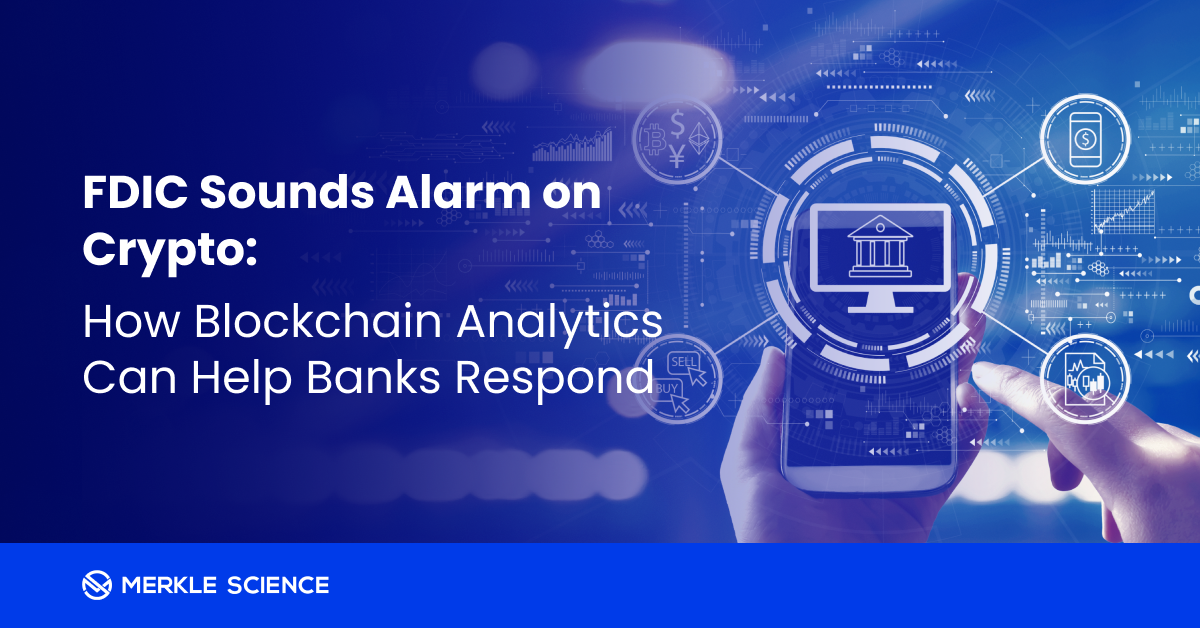FDIC Sounds Alarm on Crypto: How Blockchain Analytics Can Help Banks Respond

Merkle Science

Introduction
The Federal Deposit Insurance Corp. (FDIC) has added crypto to its annual report on risks facing U.S. banks, highlighting the "novel and complex risks" that digital assets pose to the banking system. The report is part of the FDIC's Risk Review, which provides a comprehensive summary of key developments and risks in the U.S. banking system. The FDIC has stated that it is prepared to engage in "robust supervisory discussions" with the depository institutions it oversees.
FDIC on Crypto Assets
key details and insights from the FDIC report include:
- The crypto-asset sector experienced significant volatility in 2022, exposing its vulnerabilities. Crypto-assets present novel risks that are difficult to assess fully.
- Growth in the crypto-asset industry corresponded with increasing interest by some banks in crypto-asset activities. The FDIC has been generally aware through its supervision process.
- As interest accelerated, the FDIC issued a letter asking FDIC-supervised institutions to notify the FDIC of current or intended crypto-related activities and provide information to assess risks.
- The FDIC lists concerning activities like acting as custodians, maintaining reserves, issuing assets, participating in settlement systems, and lending.
- Crypto-assets expose banks to risks like fraud, legal uncertainty, misleading disclosures, immature risk practices, and platform vulnerabilities.
- Interconnections may present concentration risk if banks have exposure to certain crypto participants. Stablecoin risks could spur deposit outflows.
Effect of Crypto on US Banking
The agency has also issued a joint statement with other federal banking agencies on the risks of crypto-asset-related activities to banking organizations. The statement highlights the risks of fraud and scams among crypto-asset sector participants, legal uncertainties related to custody practices, redemptions, and other issues, and the heightened liquidity risks that banking organizations may be exposed to due to the unpredictability of deposit inflows and outflows.
The FDIC has also expressed concern about the risks of consumer confusion or harm arising from crypto assets offered by, through, or in connection with insured depository institutions. The agency has identified 136 insured banks in the U.S. that are involved in crypto-asset activities or are planning to engage in the digital asset sector. The FDIC has reminded FDIC-supervised institutions that intend to engage in, or that are currently engaged in, any activities involving or related to crypto-assets to notify the FDIC.
How Blockchain Analytics can help Financial Institutions
The FDIC report clearly maps out the regulatory uncertainty but increasing oversight of crypto-assets is a welcoming step that compliance tools could help address. Blockchain forensics tools could help Financial Institutions and regulators track, analyze, and monitor concerning crypto activities mentioned like fraud.
- Blockchain forensic tools help banks conduct customer due diligence, transaction monitoring, and investigations related to crypto-assets.Further,
- Features like wallet clustering, transaction mapping, and identifying illicit crypto flows help banks facing crypto-related risks.
- Blockchain data complements FDIC and regulator efforts to assess crypto-asset risks, vulnerabilities, and interconnections.
- Financial Institutions incorporating systematic monitoring through on-chain and off chain data can further assist in regulatory compliance.
- Risk assessments by leveraging on-chain data can assist in tracking entity level crypto wallets to previous illicit activities.
- To perform better counterparty due diligence, using off-chain data such as the identification of the party, the respective registration within the jurisdiction can help with the implementation of robust AML/CFT and KYC measures.
Since the regulatory environment in the US is still unclear with SEC frequently pulling up crypto exchanges like Binance and Coinbase as well as assets such as Ripple for not adhering to set principles and guideline, it becomes increasingly important to partner with banks, crypto firms, regulators, and law enforcement where blockchain forensics provide insights and analytics.
Way Forward
In addition to the January statement on crypto-asset risks, the FDIC, Federal Reserve, and Office of the Comptroller of the Currency (OCC) jointly addressed liquidity dangers in February 2023. Their guidance cautioned that certain crypto funding sources may create heightened liquidity risks for banks due to the unpredictable timing and scale of crypto-related deposit flows.
The agencies advised banks to implement prudent risk management, such as monitoring exposure to crypto funding volatility. However, they emphasized banks remain free to serve all lawful customers, including crypto entities.
Meanwhile, the FDIC is closely tracking crypto activities within the banking sector per its mandate. Where appropriate, the Corporation will issue further advisories regarding crypto engagement. The FDIC has also instituted rigorous supervisory processes to discuss proposed and existing crypto services with banks.
The supervision aims to provide case-specific feedback, ensuring activities align with sound risk practices and applicable laws. In 2023, interagency crypto advisories have thus centered on managing attendant risks, while upholding banks' flexibility to operate in this emerging space. Through tailored oversight, the FDIC seeks to maintain financial stability amid crypto market evolution.


